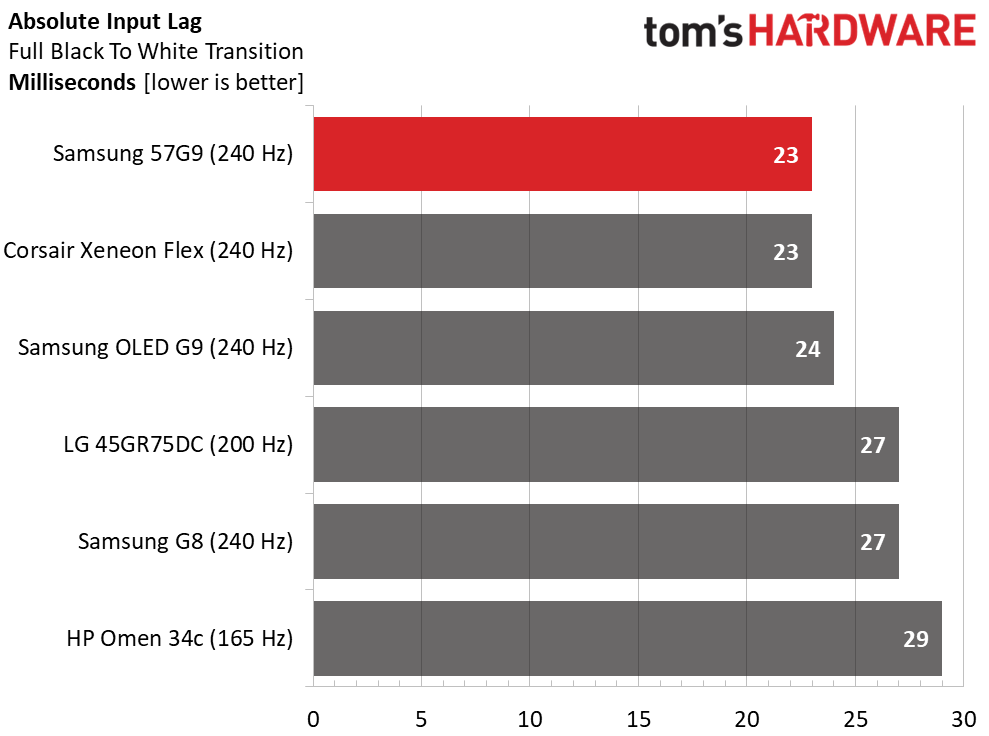Why you can trust Tom's Hardware
There isn’t anything like the 57G9 available, so I tried to find other extreme screens in my test database for comparison. The group consists of Samsung’s Odyssey OLED G9 and Neo G8 LCD, LG’s 45GR75DC, Corsair’s Xeneon Flex and HP’s Omen 34c.
Pixel Response and Input Lag
Click here to read up on our pixel response and input lag testing procedures.


Whether OLED or LCD, 240 Hz means 4ms panel response in the white field test. An OLED will make more of this result with its smoother refresh method than an LCD running at the same speed. That means OLED will have better motion resolution with no need for overdrive. Speaking of that, I tested the 57G9 with Adaptive-Sync turned on, which meant overdrive was not in play.
In the lag test, the 57G9 wins the day with a fast 23-millisecond score. It is quick to be sure with instant response to control inputs. Lag is visually non-existent. Note that these tests are run at 240 Hz, a frame rate that’s difficult to achieve at full resolution.
Test Takeaway: Given the 57G9’s unique system requirements, the best way to get the most from it is to run at 240 Hz at 5120x1440 resolution. At full resolution, frame rates are too low for a clear picture when things move quickly. It is a monitor waiting for video cards to catch up, though history has shown that the waiting period is small. When the RX 4090 or its successor adds DisplayPort 2.1 to its feature set, the 57G9 will be a perfect pairing. At 5120x1440 resolution, it looks amazing and the difference in sharpness is negligible in static images. Motion resolution is key, and the lower pixel count ensures a clearer moving image.
Viewing Angles
The 57G9 employs a VA panel to maximize contrast, but that hurts its off-axis image quality. Since the curve is so extreme, the screen remains at the same distance from the eyepoint when you turn your head. This means no visible loss of detail or color shift at the sides. At 45 degrees to the sides, you can see the expected color shift and loss of light output. The top view isn’t too bad, with a slight color shift but only a 20% brightness reduction. The 57G9 is not designed for sharing, and I can’t imagine how two people would use one simultaneously.
Screen Uniformity
To learn how we measure screen uniformity, click here.
Get Tom's Hardware's best news and in-depth reviews, straight to your inbox.
Quality control is challenging with screens this large. That the 57G9 achieves 11.64% uniformity is a good thing. When I viewed a black field pattern in a darkened room, my sample had a slight glow in the upper left and right corners. In content, it wasn’t a factor. Color and brighter gray patterns had no visible issues. Considering the size of the screen, this is excellent performance.
MORE: Best Gaming Monitors
MORE: How We Test PC Monitors
MORE: How to Buy a PC Monitor
MORE: How to Choose the Best HDR Monitor
Current page: Response, Input Lag, Viewing Angles and Uniformity
Prev Page Features and Specifications Next Page Brightness and Contrast
Christian Eberle is a Contributing Editor for Tom's Hardware US. He's a veteran reviewer of A/V equipment, specializing in monitors. Christian began his obsession with tech when he built his first PC in 1991, a 286 running DOS 3.0 at a blazing 12MHz. In 2006, he undertook training from the Imaging Science Foundation in video calibration and testing and thus started a passion for precise imaging that persists to this day. He is also a professional musician with a degree from the New England Conservatory as a classical bassoonist which he used to good effect as a performer with the West Point Army Band from 1987 to 2013. He enjoys watching movies and listening to high-end audio in his custom-built home theater and can be seen riding trails near his home on a race-ready ICE VTX recumbent trike. Christian enjoys the endless summer in Florida where he lives with his wife and Chihuahua and plays with orchestras around the state.
-
Pipsi Hello. Great review as always Christian. But there is no information on the brightness level of the monitor when it is set to strobing mode (extreme MBR option in response time tab). And most of your reviews on other monitors have that info. I ask this because I would like to buy this monitor, but the brightness in strobing mode has to be decent for me to consider it. In RTINGS review about it, they said that, while there is still extreme MBR option in the menu, it doesn't do anything when selected, and the monitor doesn't strobe at all. So naturally the brightness stays the same as in non-MBR modes. But they concluded that maybe with future upgrades to firmware the strobbing option will be available. So can you, please, measure the brightness level with the strobing (extreme MBR) option enabled to check if your particular unit has that option functional? That would mean very much to me to decide on the eventual purchase of this monitor.Reply
Kind regards,
Ivan


